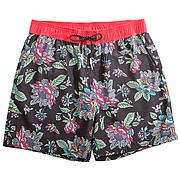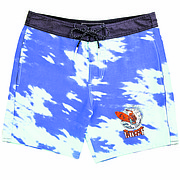MANUFACTURING
Core Surf Brand …Lost Finds New Looks
Boardshorts replaced men’s beach shorts as the swimwear of choice on the world’s surfing beaches decades ago. Now, it looks like men’s beach shorts—also called volleys—are making a comeback in the surf world.
Core surf brand …Lost, based in Orange County, Calif., has expanded its offerings of men’s volleys, said Freddie Sipowicz, Lost’s president. The major cause of the big shift was fashion. After blockbuster sales from the 1980s to the first decade of the 21st century, surf’s popularity dipped, and its styles found themselves sharing the fashion forum with streetwear and other looks. Non-surf fashions currently favor volleys with a smaller inseam.
“Beach shorts have been exploding,” he explained. “We wanted to have a presence in that category and make them with fresh, energetic prints.”
Serving as Lost’s president since February 2018, Sipowicz has made it part of his mission to make connections with contemporary youth and beach culture to blend Lost’s roots of alternative surf style in the early 1990s.
“It was more punk rock,” he said of the period following Lost’s founding by surfboard shaper Matt Biolos in 1985. “Today’s kids are different. I’d like to think that I connected two dots together.”
For Lost’s Spring 2020 collection, the brand is making 20 styles of boardshorts and 15 styles of beach shorts. Lost had a similar balance between boardshorts and beach shorts for its spring 2019 collection. But for its Spring 2018 collection, Lost only made two styles of beach shorts.
Lost’s beach shorts all have a similar silhouette. It’s a 16.5-inch inseam, and they are made from a poly-cotton material. However, the beach shorts are made with the same art and graphic designs as the line’s boardshorts. There is an emphasis on irreverence. Sipowicz described one print as taking an antiquated floral and brightening it up with an energetic graffiti feel.
Other styles include animal prints such as an earth-tone tiger stripe. But Lost designers put their own mark on the tiger-stripe print by placing fluorescent green palm trees on it. Additional looks are inspired by 1970s-style psychedelic poster art, pin-up girls and—in another nod to throwback fashion—tie-dye.
Lost’s beach shorts retail for $40, and its boardshorts range from $50 to $60. Sipowicz said that every beach-culture wardrobe should have room for boardshorts and beach shorts.
“Beach shorts are just for lounging. They are not like boardshorts, which need to perform for the elements,” he said. “Both styles are applicable to any person, whether you are a surfer or not.”
Other surf brands also have developed boardshort alternatives. Such major surf brands as Billabong, Quiksilver and Rip Curl have produced beach shorts in recent collections. But Lost can offer additional alternatives in the surf world. It is one of the only surf companies that has remained independent, Sipowicz said.
The past couple of years have represented a shift in surf. Major brands such as Hurley and Volcom were acquired by companies outside of the surf world or were involved in major consolidations, such as when archrivals Billabong and Quiksilver joined together under the aegis of Boardriders Inc.
Lost has retained its independence, Sipowicz said, and so is able to experiment and offer unique styles because the designers do not have to deal with red tape.
“We’re a small brand that made a good product presentation,” he said.
Lost has been expanding its reach through placement in an increasing number of independent retailers. In 2020, the brand anticipates adding more than 50 U.S. retailers to its list of retail partners.
During the first quarter of 2020, the company anticipates that it will begin to distribute its styles to European countries including Spain, Germany, France, Greece and England. Wherever the brand goes, it hopes to remain flexible and offer new styles with Lost graphics and attitude.
“There always is a new color palette, new treatments and new artwork,” Sipowicz said. “We get to address what is new and creatively resonating at the time.”
Photos courtesy of ... Lost"

























